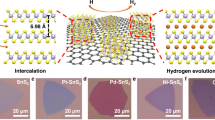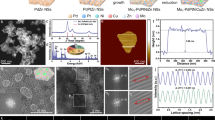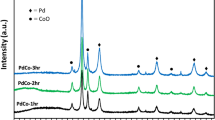Abstract
Among the most challenging issues in technologies for electrochemical energy conversion are the insufficient activity of the catalysts for the oxygen reduction reaction, catalyst degradation and carbon-support corrosion. In an effort to address these barriers, we aimed towards carbon-free multi/bimetallic materials in the form of mesostructured thin films with tailored physical properties. We present here a new class of metallic materials with tunable near-surface composition, morphology and structure that have led to greatly improved affinity for the electrochemical reduction of oxygen. The level of activity for the oxygen reduction reaction established on mesostructured thin-film catalysts exceeds the highest value reported for bulk polycrystalline Pt bimetallic alloys, and is 20-fold more active than the present state-of-the-art Pt/C nanoscale catalyst.
This is a preview of subscription content, access via your institution
Access options
Subscribe to this journal
Receive 12 print issues and online access
$259.00 per year
only $21.58 per issue
Buy this article
- Purchase on Springer Link
- Instant access to full article PDF
Prices may be subject to local taxes which are calculated during checkout





Similar content being viewed by others
References
Borup, R. et al. Scientific aspects of polymer electrolyte fuel cell durability and degradation. Chem. Rev. 107, 3904–3951 (2007).
Wagner, F. T., Lakshmanan, B. & Mathias, M. F. Electrochemistry and the future of the automobile. J. Phys. Chem. Lett. 1, 2204–2219 (2010).
Adzic, R. R. et al. Platinum monolayer fuel cell electrocatalysts. Top. Catal. 46, 249–262 (2007).
Bruce, P. G., Freunberger, S. A., Hardwick, L. J. & Tarascon, J. M. Li-O2 and Li-S batteries with high energy storage. Nature Mater. 11, 19–29 (2012).
Gasteiger, H. A., Kocha, S. S., Sompalli, B. & Wagner, F. T. Activity benchmarks and requirements for Pt, Pt-alloy, and non-Pt oxygen reduction catalysts for PEMFCs. Appl. Catal. B-Environ. 56, 9–35 (2005).
Arico, A. S., Bruce, P., Scrosati, B., Tarascon, J. M. & Van Schalkwijk, W. Nanostructured materials for advanced energy conversion and storage devices. Nature Mater. 4, 366–377 (2005).
Strasser, P. et al. Lattice-strain control of the activity in dealloyed core–shell fuel cell catalysts. Nature Chem. 2, 454–460 (2010).
Greeley, J. et al. Alloys of platinum and early transition metals as oxygen reduction electrocatalysts. Nature Chem. 1, 552–556 (2009).
Zhang, J., Sasaki, K., Sutter, E. & Adzic, R. R. Stabilization of platinum oxygen-reduction electrocatalysts using gold clusters. Science 315, 220–222 (2007).
Nilekar, A. et al. Bimetallic and ternary alloys for improved oxygen reduction catalysis. Top. Catal. 46, 276–284 (2007).
Gorlin, Y. & Jaramillo, T. F. A bifunctional nonprecious metal catalyst for oxygen reduction and water oxidation. J. Am. Chem. Soc. 132, 13612–13614 (2010).
Debe, M. K. Electrocatalyst approaches and challenges for automotive fuel cells. Nature 486, 43–51 (2012).
Snyder, J., Fujita, T., Chen, M. W. & Erlebacher, J. Oxygen reduction in nanoporous metal-ionic liquid composite electrocatalysts. Nature Mater. 9, 904–907 (2010).
Wang, C. et al. Design and synthesis of bimetallic electrocatalyst with multilayered Pt-skin surfaces. J. Am. Chem. Soc. 133, 14396–14403 (2011).
Wang, C. et al. Multimetallic Au/FePt3 nanoparticles as highly durable electrocatalyst. Nano Lett. 11, 919–926 (2010).
Ferreira, P. J. et al. Instability of Pt/C electrocatalysts in proton exchange membrane fuel cells—A mechanistic investigation. J. Electrochem. Soc. 152, A2256–A2271 (2005).
Stamenkovic, V. R. et al. Improved oxygen reduction activity on Pt3Ni(111) via increased surface site availability. Science 315, 493–497 (2007).
Stamenkovic, V. R. et al. Trends in electrocatalysis on extended and nanoscale Pt-bimetallic alloy surfaces. Nature Mater. 6, 241–247 (2007).
Stamenkovic, V., Schmidt, T. J., Ross, P. N. & Markovic, N. M. Surface composition effects in electrocatalysis: Kinetics of oxygen reduction on well-defined Pt3Ni and Pt3Co alloy surfaces. J. Phys. Chem. B 106, 11970–11979 (2002).
Stamenkovic, V. R., Mun, B. S., Mayrhofer, K. J. J., Ross, P. N. & Markovic, N. M. Effect of surface composition on electronic structure, stability, and electrocatalytic properties of Pt-transition metal alloys: Pt-skin versus Pt-skeleton surfaces. J. Am. Chem. Soc. 128, 8813–8819 (2006).
Koh, S. & Strasser, P. Electrocatalysis on bimetallic surfaces: Modifying catalytic reactivity for oxygen reduction by voltammetric surface dealloying. J. Am. Chem. Soc. 129, 12624–12625 (2007).
Zhang, J. L., Vukmirovic, M. B., Xu, Y., Mavrikakis, M. & Adzic, R. R. Controlling the catalytic activity of platinum-monolayer electrocatalysts for oxygen reduction with different substrates. Angew. Chem. Int. Ed. 44, 2132–2135 (2005).
Mukerjee, S. & Srinivasan, S. Enhanced electrocatalysis of oxygen reduction on platinum alloys in proton-exchange membrane fuel-cells. J. Electroanal. Chem. 357, 201–224 (1993).
Toda, T., Igarashi, H., Uchida, H. & Watanabe, M. Enhancement of the electroreduction of oxygen on Pt alloys with Fe, Ni, and Co. J. Electrochem. Soc. 146, 3750–3756 (1999).
Mavrikakis, M. Computational methods: A search engine for catalysts. Nature Mater. 5, 847–848 (2006).
Mani, P., Srivastava, R. & Strasser, P. Dealloyed Pt–Cu core–shell nanoparticle electrocatalysts for use in PEM fuel cell cathodes. J. Phys. Chem. C 112, 2770–2778 (2008).
Wang, C. et al. Monodisperse Pt3Co nanoparticles as a catalyst for the oxygen reduction reaction: Size-dependent activity. J. Phys. Chem. C 113, 19365–19368 (2009).
Wang, C. et al. Monodisperse Pt3Co nanoparticles as electrocatalyst: The effects of particle size and pretreatment on electrocatalytic reduction of oxygen. Phys. Chem. Chem. Phys. 12, 6933–6939 (2010).
Van der Vliet, D. et al. Platinum-alloy nanostructured thin film catalysts for the oxygen reduction reaction. Electrochim. Acta 56, 8695–8699 (2011).
Zeis, R., Mathur, A., Fritz, G., Lee, J. & Erlebacher, J. Platinum-plated nanoporous gold: An efficient, low Pt loading electrocatalyst for PEM fuel cells. J. Power Sources 165, 65–72 (2007).
Habas, S. E., Lee, H., Radmilovic, V., Somorjai, G. A. & Yang, P. Shaping binary metal nanocrystals through epitaxial seeded growth. Nature Mater. 6, 692–697 (2007).
Tao, F. et al. Reaction-driven restructuring of Rh–Pd and Pt–Pd core–shell nanoparticles. Science 322, 932–934 (2008).
Inaba, M. et al. Controlled growth and shape formation of platinum nanoparticles and their electrochemical properties. Electrochim. Acta 52, 1632–1638 (2006).
Paulus, U. A. et al. Oxygen reduction on carbon-supported Pt–Ni and Pt–Co alloy catalysts. J. Phys. Chem. B 106, 4181–4191 (2002).
Antonietti, M. & Ozin, G. A. Promises and problems of mesoscale materials chemistry or why meso? Chem. Eur. J. 10, 28–41 (2004).
Mukerjee, S., Srinivasan, S., Soriaga, M. P. & Mcbreen, J. Role of structural and electronic-properties of Pt and Pt alloys on electrocatalysis of oxygen reduction—an in-situ XANES and EXAFS investigation. J. Electrochem. Soc. 142, 1409–1422 (1995).
Debe, M. K. & Drube, A. R. Structural characteristics of a uniquely nanostructured organic thin-film. J. Vacuum Sci. Technol. B 13, 1236–1241 (1995).
Debe, M. K. & Poirier, R. J. Postdeposition growth of a uniquely nanostructured organic film by vacuum annealing. J. Vacuum Sci. Tech. A 12, 2017–2022 (1994).
Debe, M. K., Schmoeckel, A. K., Vernstrom, G. D. & Atanasoski, R. High voltage stability of nanostructured thin film catalysts for PEM fuel cells. J. Power Sources 161, 1002–1011 (2006).
Debe, M. K. in Handbook of Fuel Cells– Fundamentals, Technology and Applications (eds Vielstich, W., Lamm, A. & Gasteiger, H. A.) Ch. 45 (Wiley, 2003).
Debe, M. K. et al. Extraordinary oxygen reduction activity of Pt3Ni7 . J. Electrochem. Soc. 158, B910–B918 (2011).
Somorjai, G. A. Surface science and catalysis. Science 227, 902–908 (1985).
Tao, A. R., Habas, S. & Yang, P. D. Shape control of colloidal metal nanocrystals. Small 4, 310–325 (2008).
Lai, S. C. S. & Koper, M. T. M. The influence of surface structure on selectivity in the ethanol electro-oxidation reaction on platinum. J. Phys. Chem. Lett. 1, 1122–1125 (2010).
Wadayama, T. et al. Oxygen reduction reaction activities of Ni/Pt(111) model catalysts fabricated by molecular beam epitaxy. Electrochem. Commun. 12, 1112–1115 (2010).
Gancs, L., Kobayashi, T., Debe, M. K., Atanasoski, R. & Wieckowski, A. Crystallographic characteristics of nanostructured thin-film fuel cell electrocatalysts: A HRTEM study. Chem. Mater. 20, 2444–2454 (2008).
Subbaraman, R., Strmcnik, D., Paulikas, A. P., Stamenkovic, V. R. & Markovic, N. M. Oxygen reduction reaction at three-phase interfaces. ChemPhysChem 11, 2825–2833 (2010).
Debe, M. K. et al. Nanostructured thin film catalysts for PEM fuel cells by vacuum web coating. (Society of Vacuum Coaters—50th Annual Technical Conference Proceedings, 2007).
Acknowledgements
The research was conducted at Argonne National Laboratory, which is a US Department of Energy Office of Science Laboratory operated by UChicago Argonne, LLC under contract no. DE-AC02-06CH11357. The portion of work related to extended single-crystalline and thin-film surfaces was supported by the US Department of Energy, Office of Science, Office of Basic Energy Sciences, Materials Sciences and Engineering Division. The portion of work exploring practical thin-film-based electrocatalysts was supported by the Office of Energy Efficiency and Renewable Energy, Fuel Cell Technologies Program. The authors thank Hitachi High Technologies America for the access to high-resolution electron microscopy facilities and J. Pearson and A. P. Paulikas for supporting thin film deposition experiments. V.R.S. is grateful to S. D. Bader and G.W. Crabtree for productive discussions.
Author information
Authors and Affiliations
Contributions
D.F.V., C.W. and V.R.S. designed the experiments. C.W., D.F.V., D.T., D.S., X.F.Z., R.T.A., M.K.D. and V.R.S. carried out the experimental work. D.F.V., C.W., M.K.D., N.M.M. and V.R.S. discussed the results and V.R.S. wrote the manuscript.
Corresponding authors
Ethics declarations
Competing interests
The authors declare no competing financial interests.
Supplementary information
Supplementary Information
Supplementary Information (PDF 1284 kb)
Rights and permissions
About this article
Cite this article
van der Vliet, D., Wang, C., Tripkovic, D. et al. Mesostructured thin films as electrocatalysts with tunable composition and surface morphology. Nature Mater 11, 1051–1058 (2012). https://doi.org/10.1038/nmat3457
Received:
Accepted:
Published:
Issue Date:
DOI: https://doi.org/10.1038/nmat3457
This article is cited by
-
Conversion of magnetron-sputtered sacrificial intermediate layer into a stable FeCo-LDH catalyst for oxygen evolution reaction
Nano Research (2024)
-
3D microprinting of inorganic porous materials by chemical linking-induced solidification of nanocrystals
Nature Communications (2023)
-
Development of electrochemistry in Serbia-challenges and perspectives
Journal of Solid State Electrochemistry (2023)
-
Trimetallic PtTiMg Alloy Nanoparticles with High Activity for Efficient Electrocatalytic Ethanol Oxidation
Catalysis Surveys from Asia (2022)
-
Fluorination-enabled interface of PtNi electrocatalysts for high-performance high-temperature proton exchange membrane fuel cells
Science China Materials (2022)



